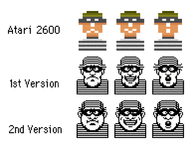Andy
Well-known member
@Crutch There's a nice MAME frontend called Ample specifially for running Macs and Apple computers. It Presents options in drop downs and also shows you the cli flags configured. https://github.com/ksherlock/ample
Hang on while I send you my standard NDA.This is a magical thread. The popping sound solve is pure joy. Do you mind if your solution is heavily inspired from and adapted?

; -----------------------------------------------------------------------------
; Initialize all global variables to NIL
INIT_GLOBALS
LEA BeginGlobals(A5),A0 ; Load first marker address
LEA EndGlobals(A5),A1 ; Load last marker address
SUB.L A0,A1 ; Subtract to get bytes
MOVE.L A1,D0 ; Move into data register
SUB #1,D0 ; Subtract one for loop
@NIL CLR.B (A0)+ ; Set byte to NIL
DBRA D0,@NIL ; Loop until done
RTS ; Return from subroutine
; -----------------------------------------------------------------------------
; Define global variables that are relative to A5
BeginGlobals DS.L 0 ; (zero-byte address marker)
EvWindow DS.L 1 ; Window where event happened
EvRecord DS.W 0 ; Start of event record
EvNum: DS.W 1 ; Event number
EvMessage: DS.L 1 ; Additional information
EvWhen: DS.L 1 ; Time event happened
EvPoint: DS.L 1 ; Mouse coordinates of event
EvModify: DS.W 1 ; State of keys and button
Menu1 DS.L 1 ; Handle for menu 1 (Apple)
Menu2 DS.L 1 ; Handle for menu 2
Menu3 DS.L 1 ; Handle for menu 3
; ... lots more A5 variables ...
EndGlobals DS.L 0 ; (zero-byte address marker)